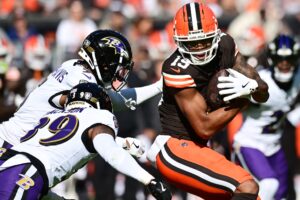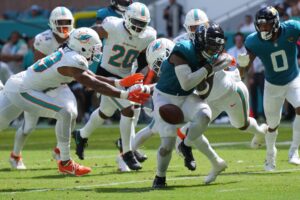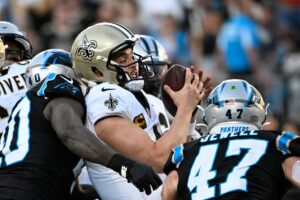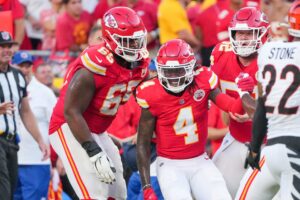With elite receiver Odell Beckham Jr. already in-tow, the New York Giants made additional strides in their personnel that directly impact the difficulty of defending him. Defensively, the Giants’ efficiency was an integral part of the team’s overall success and granted the offense with increased opportunities. As we conclude the NFC East’s portion of the “The Breakdown,” we take a look at the New York Giants schematic philosophy.
The Breakdown: A Look at the New York Giants Schematic Philosophy
The Importance of Cohesion
Quarterback Eli Manning returns for an unparalleled 14th season as the Giants quarterback, and 2017 has the chance to be one of his most productive yet. They added former New York Jets receiver Brandon Marshall and drafted Ole Miss tight end Evan Engram, a flexible, athletic pass catcher who won’t be pigeon-holed into basic in-line duties, in the first round this past April. Add in 2016 second rounder Sterling Shepard, and you have one of the league’s most dynamic group of aerial weapons.
The Giants are unquestionably a base 11 personnel team, but with Engram expected to earn the starting tight end job, they essentially have four lethal receiving options and will likely expand into four (10 personnel) and five-wide groupings with the addition of Marshall.
Adding the two aforementioned pass catchers has an immeasurable value to an offense comprised of an in and out breaking, quick-strike plays that made things easier for defenses by aligning Beckham along the perimeter on the majority of their offensive snaps rather than shuffling him around and putting him in motion pre-snap at the desired rate.
Marshall, Beckham and Shepard have all seen quality snaps in the slot, while the former two have traditionally been X receivers. This versatility is of major importance when you factor in Engram’s ability to stress the seams and intermediate level of a defense, forcing them to honor these skills. He’s naturally going to draw coverage his way to prevent his penchant for big plays and will ultimately open up opportunities for others.
Operating in 11 personnel with such regularity affects how the run game is structured as well. The more receivers on the field, the less additional help running backs have from fullbacks and tight ends, which simultaneously increases the amount of insufficient gap scenarios. While the Giants have become reliant on inside zone runs due to their fairly un-athletic interior offensive line, the addition of Engram should provide a boost as a flexible blocker who can be put in pre-snap motion and handle blocking duties on the fly to manipulate the point-of-attack.
Running backs Paul Perkins and Shane Vereen are known receiving threats out of the backfield, and when you further consider the addition of Engram, the Giants can now send out five viable pass catchers from their 11 personnel. Doing so enhances their play design and play call, making it increasingly difficult for the defense to implement blitz packages and coverage rotations when they have a consistent threat of five receivers from a variety of alignments.
The Spagnuolo Effect
Defensive coordinator Steve Spagnuolo enters his third season as the Giants defensive coordinator in his second stint at such post. Spagnulo coordinated their defense from 2007-2008, winning Super Bowl XLII.
As previously mentioned, the Giants were one of the league’s most efficient, well-rounded units, and it all stems from the desire to generate pressure. For starters, Spagnuolo doesn’t save his blitz packages for the majority of third downs, but rather dials them up whenever he sees fit, independent of the down-and-distance. He incorporates a bevy of deeper blitzes-defenders coming from linebacker and safety depth-that embodies the true importance of disguise.
Spagnuolo can operate from a blitz-heavy scheme because of the talent in the back-end comprised of corners Janoris Jenkins, Eli Apple and Dominique Rodgers-Cromartie and safety Landon Collins. This level of talent in the secondary opens the door to the possibilities of bringing Cover 2 shell blitzes as opposed to the standard single-high pressures, further enhancing the ability to disguise.
New York’s recent investments in the front-four are no coincidence either. They signed defensive end Olivier Vernon to a massive deal and defensive tackle Damon Harrison prior to last season, and spent their second round pick in last April’s draft on 3-Tech Dalvin Tomlinson. Building a dominant line allows defenses to attack the passer through simple four-man rushes with intertwined slants and stunts, but also allows the defense to expand on the creativity of their blitz alignments and positioning, an ever-important factor in that aspect of defense. It’s not unusual for Spagnuolo to shift both his fronts and coverage before the snap, which ultimately ties back into the variety of blitz packages he can incorporate.
From a personnel standpoint, many of the moves they have made directly influence one another. General manager Jerry Reese has long been a believer in building a defensive force anchored by a dominant line with marginal talent behind them at linebacker; rarely are large sums of money and valuable draft capital spent at the position.
Rodgers-Cromartie has proven to be the reliable slot corner many expected Apple to become, while the combined aggressive nature of the latter and Jenkins lead to the additions of the aforementioned pass rushers in a wise move: a threatening pass rush forces quarterbacks to become trigger-happy and allow the attacking secondary to capitalize. Not to be outdone, Collins has quickly become a rising star and no-longer the box safety many thought he wouldn’t expand upon, rather one who can handle coverage responsibilities from both two-high spots, roll down into a Robber role and effectively generate pressure as a blitzer.
Any other year, the Giants’ 11-5 record likely would have secured the top spot in the NFC East, but the Dallas Cowboys experienced a run we may never see again. New York has retained their defensive talent and made the quality additions on offense that should place them squarely in position to finish as the division’s top dog, but not dropping both games to the Philadelphia Eagles is imperative. Keep a close watch on this competitive division in 2017.
Main Image:






